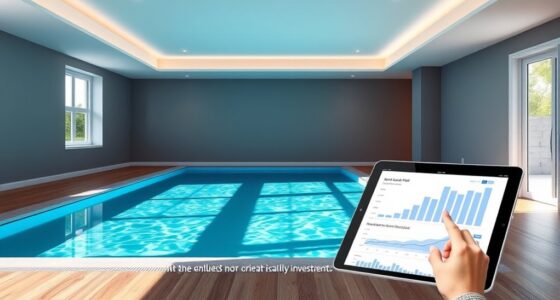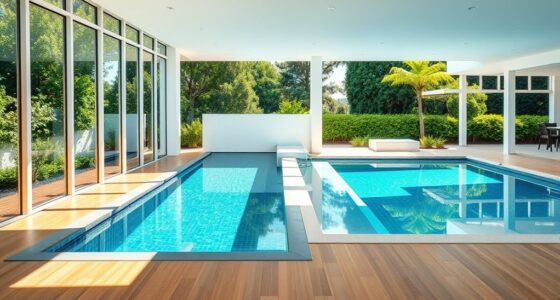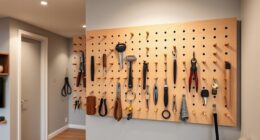To create an effective endless pool training plan as a triathlete, start by honestly evaluating your current swimming skills and setting clear goals for endurance, speed, and technique. Design a weekly schedule that balances endurance sessions, technique drills, and interval work, incorporating resistance tools like paddles and fins. Track your progress and adjust as needed to prevent stagnation. Keep consistency and variety in your routine—if you continue exploring, you’ll discover how to fine-tune your plan for peak performance.
Key Takeaways
- Customize workout routines to include endurance, speed, and technique drills tailored for an endless pool environment.
- Incorporate interval training with high-intensity sprints and recovery periods to boost stamina and performance.
- Use resistance tools like paddles and fins within the pool to enhance muscle strength and propulsion.
- Regularly monitor metrics such as pace and stroke rate to adjust workouts and track progress effectively.
- Schedule varied sessions to prevent plateaus, including technique refinement, endurance, and recovery days.
Assessing Your Current Swimming Ability and Setting Goals
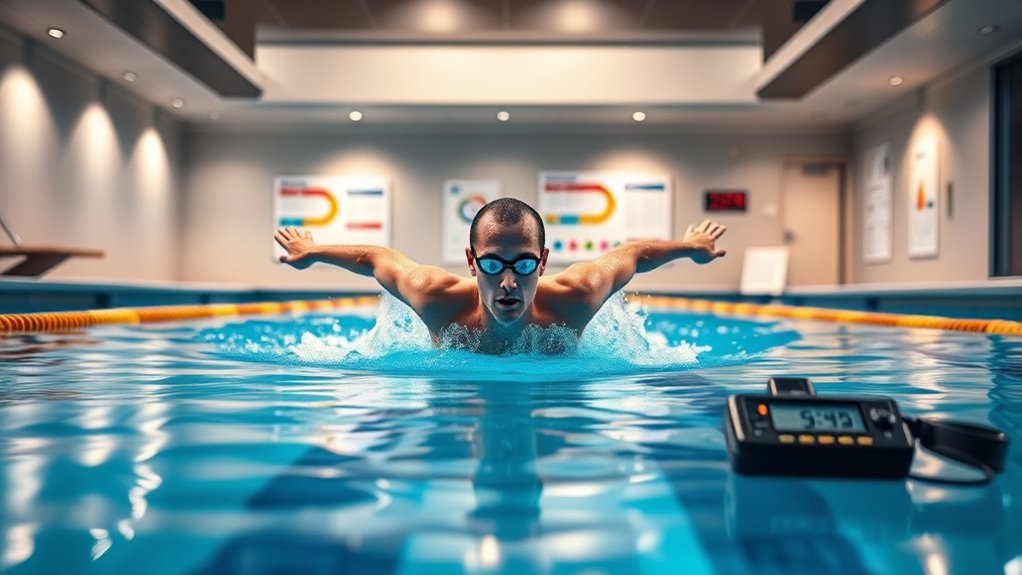
Before you begin your training, it’s essential to honestly assess your current swimming ability and set clear, achievable goals. Take time to evaluate your comfort level in the water, your stroke efficiency, and your endurance. Do you struggle with breathing, maintaining form, or completing certain distances? Identifying these areas helps you understand where to focus and how much improvement is needed. Set specific goals, like improving your pace, increasing your stamina, or mastering a particular technique. Make sure your goals are realistic and measurable, so you can track progress over time. This honest assessment and goal-setting provide a solid foundation for your training plan, ensuring you stay motivated and targeted throughout your journey. Additionally, understanding your current swimming technology and equipment can help tailor your training to maximize effectiveness.
Designing a Weekly Training Schedule for Endurance and Technique
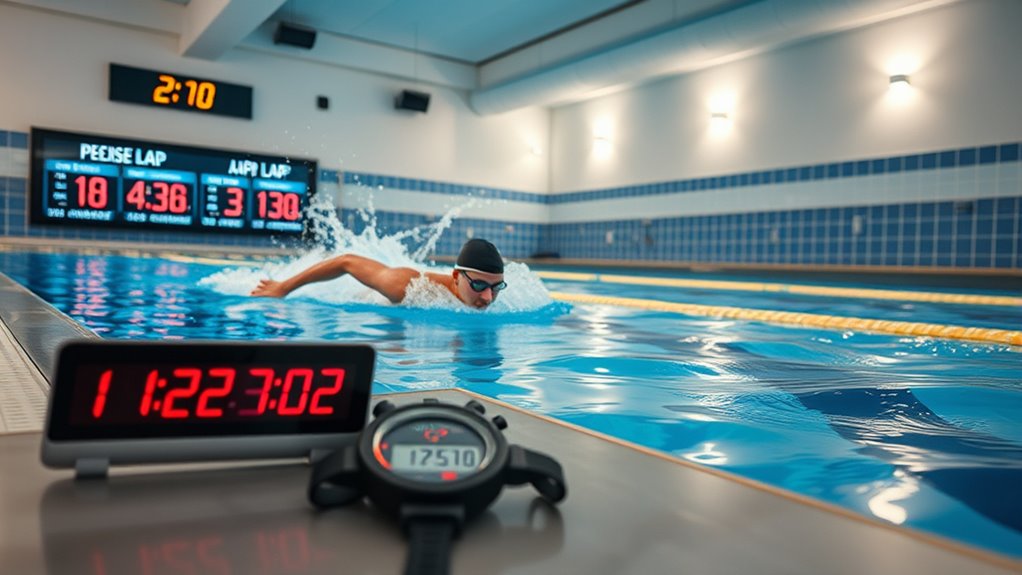
Creating a balanced weekly training schedule is key to building both endurance and technique on your Endless Pool. To maximize progress, allocate specific days to different focuses. For example, dedicate some sessions to steady-state swimming to boost endurance, while others focus on drills that refine your technique. Consistency is essential, so aim for a mix of longer swims and shorter, skill-focused workouts. Incorporate variety to prevent plateaus and keep motivation high. Additionally, reviewing Advanced Techniques can help you implement new drills and strategies into your routine. Consider these strategies:
- Schedule endurance swims early in the week when energy levels are high
- Reserve technique drills for days when you need lighter, focused sessions
- Include rest or active recovery days to allow your body to adapt and avoid burnout
Incorporating Interval and Speed Work Into Your Routine
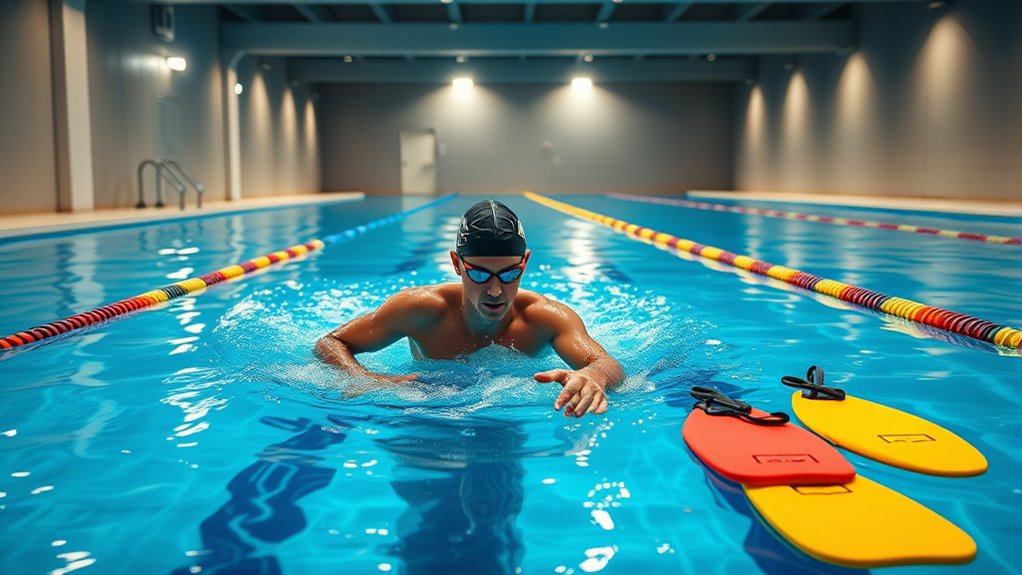
Incorporating interval and speed work into your Endless Pool training can considerably boost your overall performance by increasing your power and efficiency. To do this effectively, alternate between high-intensity sprints and recovery periods. For example, swim hard for 30 seconds, then slow down for 60 seconds, and repeat. This approach pushes your cardiovascular system and builds muscular endurance. Be sure to warm up thoroughly before starting intervals to prevent injury. Keep your form sharp during all efforts, focusing on powerful pull and streamlined body position. Gradually increase the intensity and duration of your sprints over time to avoid burnout. Incorporating these sessions 1-2 times a week can lead to faster race times and improved stamina across all triathlon disciplines. Additionally, maintaining biodiversity in your training environment by varying your routines can help prevent plateaus and keep motivation high.
Using Resistance and Technique Drills to Enhance Efficiency

Using resistance and technique drills is essential for improving your swimming efficiency and conserving energy during race day. These drills help refine your stroke mechanics, increase strength, and reduce drag. Incorporate tools like pull buoys, paddles, and fins to target specific muscle groups and improve propulsion. Focus on maintaining proper body position and smooth, controlled movements. Techniques such as catch-up drills, single-arm swimming, or bilateral breathing emphasize form and coordination. These exercises build muscle memory, making your stroke more efficient under fatigue. Regularly practicing these drills in your endless pool ensures you’re developing better habits and reducing energy waste. Additionally, paying attention to body position during drills can significantly enhance overall performance. Ultimately, this focus on technique and resistance prepares you to swim faster with less effort during your triathlon.
Monitoring Progress and Adjusting Your Training Plan
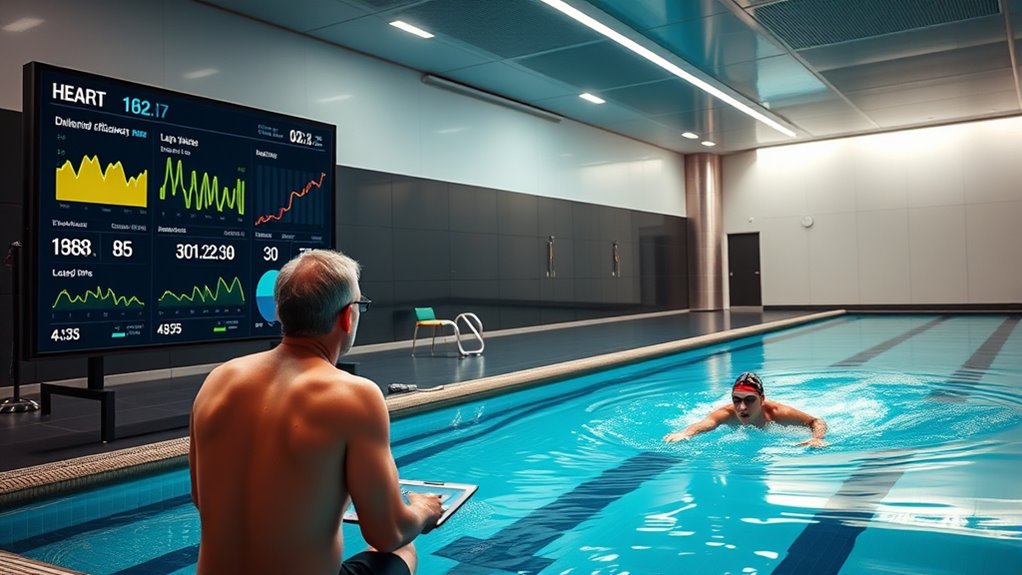
Monitoring your progress is crucial to guarantee your training stays effective and aligned with your goals. Regularly track your performance through metrics like pace, stroke count, and heart rate to identify improvements or plateaus. Pay attention to how you feel during and after workouts—signs of fatigue or discomfort may signal the need for adjustments. Use data from your endless pool sessions to refine your training plan, increasing intensity or volume gradually. If you notice stagnation, consider incorporating new drills or recovery days. Flexibility is key; don’t hesitate to modify your plan based on progress or setbacks. Consistent evaluation ensures you stay motivated, avoid overtraining, and optimize your training for peak performance in your triathlon. Detecting passive voice can help you improve clarity and engagement in your writing.
Frequently Asked Questions
What Is the Ideal Water Temperature for Triathlon Training?
The ideal water temperature for triathlon training is between 78 and 82°F (25.5 to 27.5°C). You should aim for this range to mimic race conditions, ensuring your body adapts well without overheating or feeling too cold. Staying within this temperature helps you build endurance and confidence in the water, making your training more effective. Always listen to your body and adjust if you feel uncomfortable.
How Do I Prevent Injury During Intense Swim Sessions?
To prevent injury during intense swim sessions, focus on proper technique, warm up thoroughly, and listen to your body. Incorporate strength and flexibility exercises to support your muscles and joints. Gradually increase workout intensity and volume to avoid overtraining. Stay hydrated, guarantee correct breathing, and take regular rest days. If you feel pain or discomfort, stop immediately and seek professional advice to prevent long-term damage.
Can I Use an Endless Pool for Open Water Technique?
Yes, you can use an endless pool to practice open water techniques. It allows you to work on sighting, navigation, and stroke mechanics in a controlled environment. You can simulate open water conditions by adjusting water flow, adding visibility markers, and practicing turns. While it doesn’t perfectly mimic open water, it’s a valuable tool for refining your skills, building confidence, and maintaining technique when outdoor conditions aren’t ideal.
What Equipment Is Necessary Besides the Pool Itself?
You’ll need a few essential items to optimize your endless pool training. A waterproof swim watch helps track your performance, while a pull buoy or fins can target specific muscles and improve technique. Consider a kickboard for leg work and a snorkel for breathing practice. Additionally, a waterproof speaker or headphones can keep you motivated. Finally, make certain you have proper swimwear, goggles, and a towel for comfort and convenience.
How Often Should I Replace or Upgrade My Pool Equipment?
Imagine your pool equipment as the gears of a finely-tuned machine, essential for peak performance. You should replace or upgrade your equipment every 1 to 3 years, depending on usage and wear. Regularly inspect for rust, cracks, or malfunctions. Upgrading older gear keeps your training efficient and safe, ensuring you stay in top form for your triathlon goals. Stay vigilant, and your equipment will serve you well.
Conclusion
By following this endless pool training plan, you’ll open your true swimming potential and transform into a triathlon powerhouse. Stay committed, track your progress, and tweak your workouts as needed—soon, you’ll feel like you’re slicing through water faster than a lightning bolt striking the ocean. Remember, every splash and stroke brings you closer to conquering your goals. Keep pushing forward, and watch your swimming skills soar into the stratosphere of excellence!




